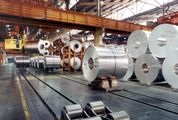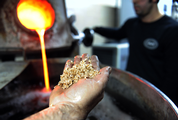Mine chiefs not so hot at commodity picks
by David Fickling,
2016-03-18 06:31:09.0
SYDNEY — Mining executives, like the commodities they manage, tend to go in and out of fashion according to long, hard-to-predict cycles. So you could take Rio Tinto’s decision to appoint Jean-Sébastien Jacques as CEO as a bad sign for copper, the metal he has spent most of his recent career digging up.
Looking back on the previous six appointees at the traditional big three London-traded mining companies, one could be forgiven for imagining that their boards attracted some sort ofancient curse while looking for mineral reserves in the rougher corners of the planet. Why? Because the background of a new CEO isa weirdly reliable contrarian indicator of commodities that might head southover the next few years. Traders who drove copper up to $5,062 a metric tonne on Thursday might heed that warning.
At Rio Tinto, Mr Jacques is replacing Sam Walsh, a former General Motors executive who took charge of Rio’s iron-ore division in 2004, just as China’s industrialisation began propelling the metal towards a peak of $192 a metric tonne in 2011.
Walsh, who started in 2013, replaced Tom Albanese, who took on the job in 2007 after running Rio’s copper group as the metalmore than tripledin price between 2004 and 2006.
With a background overseeing divisions that delivered such outsized returns to shareholders in recent years, both executives must have seemed like safe pairs of hands to look after the company as a whole.
It didn’t work out: in each case, the past outperformance eventually looked like the market bidding up prices it was about to start bidding down.
There are parallels at Anglo American and, more tentatively, at BHP Billiton. Whileshe was in charge of Alcan’s primary aluminium division, former Anglo American CEO Cynthia Carroll had watched aluminium double in price.
The commodity was seen as so attractive that Rio Tinto’s Mr Albanese, only a few months in the job, launched a $38bn takeover bid for Alcan, from whose shadow he never really escaped.
Mark Cutifani, who replaced Carroll in 2013, had been the boss of AngloGold Ashanti when the metal rose to an all-time record $1,921a troy ounce.
At BHP, the current CEO, Andrew Mackenzie, came with a long career at BP on his curriculum vitae at a time when Brent crude had averaged more than $100 a barrel over three years. We all know what has happened to oil since then.
These are light-hearted comparisons, but there’s a serious point: mining executives, analysts, board members — even business columnists — are often bad at picking the direction of commodity prices. The tendency to believe that past performance is a guide to the direction of future returns appears to be almost irresistible. However much care wetake in making predictions, we should expect to be wrong more often than not.
In the meantime, Mr Mackenzie and Mr Cutifani may have cause to be nervous. Mining CEOs tend to come in threes. In 2007 and 2013, when the first of the big three miners switched bosses, their counterparts did not last more than seven months.
Bloomberg

Sébastien Jacques. Picture: BLOOMBERG/SIMON DAWSON
SYDNEY — Mining executives, like the commodities they manage, tend to go in and out of fashion according to long, hard-to-predict cycles. So you could take Rio Tinto’s decision to appoint Jean-Sébastien Jacques as CEO as a bad sign for copper, the metal he has spent most of his recent career digging up.
Looking back on the previous six appointees at the traditional big three London-traded mining companies, one could be forgiven for imagining that their boards attracted some sort ofancient curse while looking for mineral reserves in the rougher corners of the planet. Why? Because the background of a new CEO isa weirdly reliable contrarian indicator of commodities that might head southover the next few years. Traders who drove copper up to $5,062 a metric tonne on Thursday might heed that warning.
At Rio Tinto, Mr Jacques is replacing Sam Walsh, a former General Motors executive who took charge of Rio’s iron-ore division in 2004, just as China’s industrialisation began propelling the metal towards a peak of $192 a metric tonne in 2011.
Walsh, who started in 2013, replaced Tom Albanese, who took on the job in 2007 after running Rio’s copper group as the metalmore than tripledin price between 2004 and 2006.
With a background overseeing divisions that delivered such outsized returns to shareholders in recent years, both executives must have seemed like safe pairs of hands to look after the company as a whole.
It didn’t work out: in each case, the past outperformance eventually looked like the market bidding up prices it was about to start bidding down.
There are parallels at Anglo American and, more tentatively, at BHP Billiton. Whileshe was in charge of Alcan’s primary aluminium division, former Anglo American CEO Cynthia Carroll had watched aluminium double in price.
The commodity was seen as so attractive that Rio Tinto’s Mr Albanese, only a few months in the job, launched a $38bn takeover bid for Alcan, from whose shadow he never really escaped.
Mark Cutifani, who replaced Carroll in 2013, had been the boss of AngloGold Ashanti when the metal rose to an all-time record $1,921a troy ounce.
At BHP, the current CEO, Andrew Mackenzie, came with a long career at BP on his curriculum vitae at a time when Brent crude had averaged more than $100 a barrel over three years. We all know what has happened to oil since then.
These are light-hearted comparisons, but there’s a serious point: mining executives, analysts, board members — even business columnists — are often bad at picking the direction of commodity prices. The tendency to believe that past performance is a guide to the direction of future returns appears to be almost irresistible. However much care wetake in making predictions, we should expect to be wrong more often than not.
In the meantime, Mr Mackenzie and Mr Cutifani may have cause to be nervous. Mining CEOs tend to come in threes. In 2007 and 2013, when the first of the big three miners switched bosses, their counterparts did not last more than seven months.
Bloomberg





















Change: 1.19%
Change: 1.36%
Change: 2.19%
Change: 1.49%
Change: -0.77%
Data supplied by Profile Data
Change: -0.19%
Change: 0.69%
Change: 1.19%
Change: 0.00%
Change: 0.44%
Data supplied by Profile Data
Change: 0.62%
Change: 0.61%
Change: 0.23%
Change: 0.52%
Change: 0.12%
Data supplied by Profile Data
Change: -0.21%
Change: -1.22%
Change: -0.69%
Change: -0.51%
Change: 0.07%
Data supplied by Profile Data